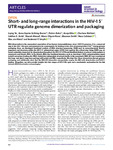2022-03-28Zeitschriftenartikel
Short- and long-range interactions in the HIV-1 5′ UTR regulate genome dimerization and packaging
Ye, Liqing
Gribling-Burrer, Anne-Sophie
Bohn, Patrick
Kibe, Anuja
Börtlein, Charlene
Ambi, Uddhav B.
Ahmad, Shazeb
Olguin-Nava, Marco
Smith, Maureen
Caliskan, Neva
von Kleist, Max
Smyth, Redmond P.
RNA dimerization is the noncovalent association of two human immunodeficiency virus-1 (HIV-1) genomes. It is a conserved step in the HIV-1 life cycle and assumed to be a prerequisite for binding to the viral structural protein Pr55Gag during genome packaging. Here, we developed functional analysis of RNA structure-sequencing (FARS-seq) to comprehensively identify sequences and structures within the HIV-1 5′ untranslated region (UTR) that regulate this critical step. Using FARS-seq, we found nucleotides important for dimerization throughout the HIV-1 5′ UTR and identified distinct structural conformations in monomeric and dimeric RNA. In the dimeric RNA, key functional domains, such as stem-loop 1 (SL1), polyadenylation signal (polyA) and primer binding site (PBS), folded into independent structural motifs. In the monomeric RNA, SL1 was reconfigured into long- and short-range base pairings with polyA and PBS, respectively. We show that these interactions disrupt genome packaging, and additionally show that the PBS–SL1 interaction unexpectedly couples the PBS with dimerization and Pr55Gag binding. Altogether, our data provide insights into late stages of HIV-1 life cycle and a mechanistic explanation for the link between RNA dimerization and packaging.
Files in this item

